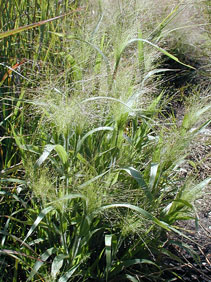WITCHGRASS
|
 |
| File Size: 162 KB |
|
|
|
Panicum capillare L.
|
| Tallgrass Prairie National Preserve, Chase County, Kansas |
| Annual |
| Height: 8-28 inches |
| Family: Poaceae - Grass Family |
| Flowering Period: July, August, September |
|
| Also Called: | | Ticklegrass. | | Culms: | | Erect or spreading from decumbent bases, simple or sparingly branched, hollow, pubescent near nodes. | | Blades: | | Blades flat or folded, 2 to 10 inches long, 1/4 to 1/2 inch wide, surfaces and lower margins with long, soft hairs, midrib prominent. | | Sheaths: | | Usually longer than internodes, densely long-hairy. | | Ligules: | | Short fringes of hairs. | | Inflorescences: | | Panicles, open, spreading, 4 to 12 inches long, nearly as broad, frequently 1/2 length of entire plant, often partially enclosed in uppermost sheaths, usually purplish at maturity; branches numerous, slender, bearing spikelets near ends. | | Spikelets: | | Long-stalked, 2-flowered, elliptic, about 1/10 inch long; tips sharp-pointed; glumes unequal; lemmas 1 fertile, 1 sterile; awns absent. | | Habitat: | | Waste ground, disturbed areas, cultivated fields, and roadsides, in dry or sandy soils. | | Distribution: | | Throughout Kansas. | | Forage Value: | | It provides little forage value and rarely is grazed. However, the fruits are an important food source for quail. | | Comments: | | Witchgrass is a weedy species that invades areas where there is little competition. After maturity, the panicles break off and roll like tumbleweeds. |
|
| Witchgrass inflorescence |  | | 144 KB | | Tallgrass Prairie National Preserve, Chase County, Kansas |
| | Witchgrass sheath and blade hairs |  | | 70 KB | | Konza Prairie, Riley County, Kansas |
| | Witchgrass |  | | 183 KB | | Konza Prairie, Riley County, Kansas |
| | Witchgrass |  | | 177 KB | | Tallgrass Prairie National Preserve, Chase County, Kansas |
| | |
|
|
|
|
|
|